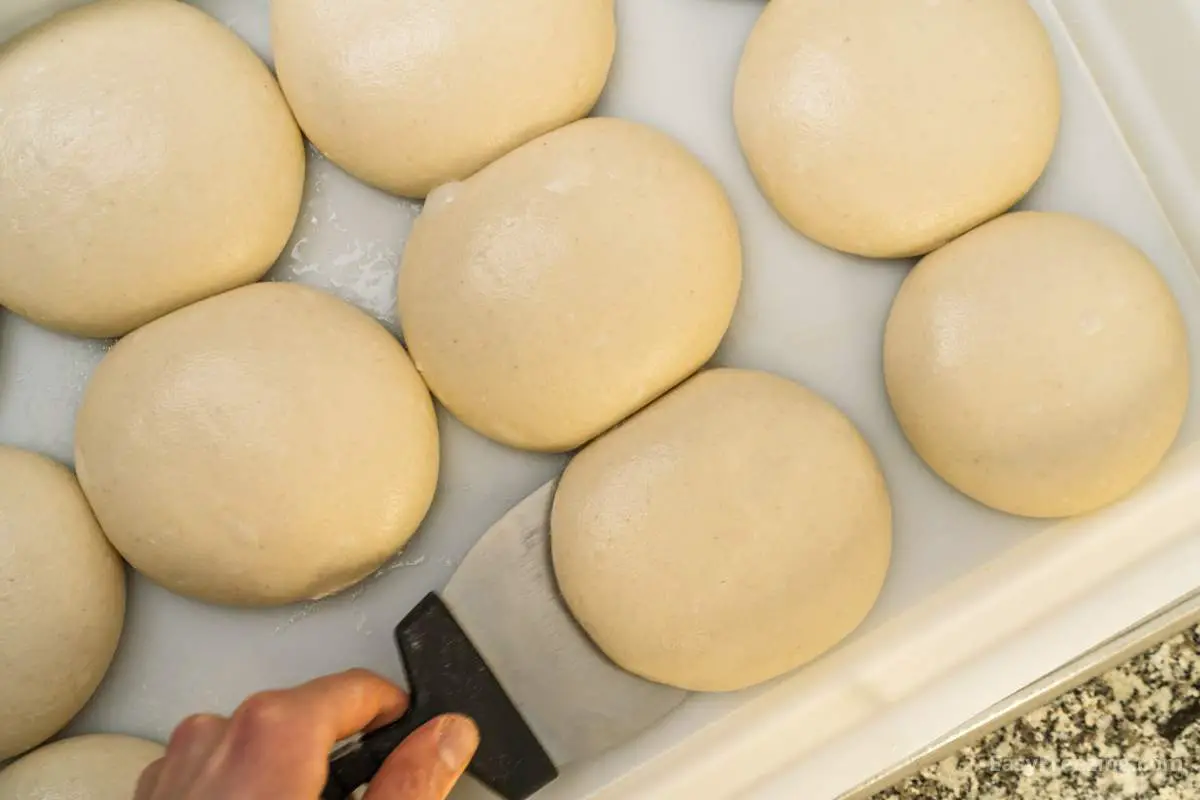Freezing Homemade Bread Dough (How To)
If you have ever made bread, you know it’s not possible to whip up those tasty loaves in a short amount of time. However, you can cut your preparation time way down by stashing some bread dough in the freezer in advance for later use. This saves time as well as space since frozen dough takes less space than a baked loaf in the freezer.
From flatbread to balls of pizza dough, freezing requires nothing but technique and some extra time. In this article, I’ll tell you all about freezing homemade bread dough so you can thaw, bake and enjoy later!
Are you bready? LOL!

Can you Freeze Bread Dough?
Yes, you can definitely freeze bread dough! Although, some types of bread are suited better to freezing than others. Breads that are lower in salt and fats and have a higher concentration of yeast and sugar freeze easily. Common examples include simple homemade bread (recipe) and pizza dough.
The dough can be frozen at two different stages of preparation. The first opportunity to freeze bread dough occurs between the end of the kneading process and the beginning of the first rise. The second is just before the second rise after the dough has been moulded.
Even though freezing bread dough might seem quite convenient, be warned that frozen dough will never rise as well as a fresh batch since some of the yeast will die in the freezer too. Worry not, though, as I will tell you how to counter this in the next section!

How to Freeze Bread Dough?
If you are preparing a bread dough recipe in order to freeze it, you will want to increase the amount of yeast you add by ¼ to ½ teaspoon per 3 cups (360g) of flour to make up for the yeast that dies off in the freezer.
In general, follow any recipe that you like but add two times the amount of yeast mentioned so that you have some working yeast at the end.
For freezing bread dough, you will need the dough, some aluminum foil or plastic wrap, and a pan to bake it in.
Freezing Dough Before the First Rise
- Place some dough discs in the freezer for an hour after you have rolled them out.
- Once the dough freezes, cover it securely in plastic or aluminum foil and put them into freezer bags. Press out the excess air, then seal the plastic bags and place them back in the freezer.
- If sealed properly, bread dough can be stored in the freezer for up to four weeks.
- When you’re ready to use it later, thaw it in the fridge overnight, followed by leaving it in a warm place for the first rise.
- Thawed dough that has been frozen will take twice as long to rise compared to fresh dough.
- Punch it down to the desired shape and let it rise for the second time.
Freezing Dough After Shaping
- Allow the bread to rise in a greased dish.
- Once the bread doubles in size, punch it down and knead it. Shape it in the form of as many loaves as you like.
- After this, start placing the loaves in a bread pan lined with plastic wrap. This will also help the bread retain its shape.
- Transfer the pan and bread stacks wrapped in plastic into the freezer and let them sit for about 10 hours.
- Once thoroughly frozen, place the wrapped dough loaves into freezer bags and press out the air in the bag before sealing. Make sure to label the bags with the date and type of bread dough before placing them inside the freezer.
- You can use this dough within 4-6 weeks of freezing.
Freezing Muffins & Quick Breads
- Line a loaf pan with plastic wrap or use a muffin tin with some silicone baking cups (Amazon).
- Pour some batter into the pan and place it inside the freezer overnight.
- Now wrap the batter in plastic wrap and put it in a freezer-safe bag.
- Butter the same loaf pan you used before and remove the frozen batter from the plastic wrap before baking.
- Once you are ready to use it, place it in the oven and bake accordingly.
- When freezing pie crusts, avoid rolling them out and gather all the crust. Shape it in the shape of a ball and then put it in a freezer-safe container.
- When freezing tortillas, let them cool completely before placing them on a baking sheet. Much like pie crusts, tortillas can also be placed in a freezer-safe container and baked.

Additional Bread & Bread Dough Freezing Tips
Here are a few tips and tricks to keep in mind when freezing homemade bread dough:
- Prepare bread rolls in advance, followed by baking, cooling, and wrapping them firmly before freezing. Once you are ready to use the bread, reheat the dough in the oven at 350˚F while tenting with foil if necessary.
- Naturally leavened dishes are best cooked without having been frozen since sourdough starter is significantly more sensitive than commercial yeast.
- When looking at a recipe that tells how to prepare two or more loaves while you just want to make one, simply divide the volume of all ingredients, including salt and yeast, by 2.
- Instead of freezing bread, you can always make a double batch. In this manner, you will just need one day and have enough bread to last you the whole month.
Bonus: Freezing Pizza Dough
It’s always nice to have some of your own healthy pizza dough. Start by preparing one or two batches of pizza dough, depending on your needs. Next up, let it rise (this can take between 10-30 minutes).
Once you are finished with the rise, pound out the air bubbles and fold the dough over itself 5-10 times. Then double wrap the pizza dough to avoid freezer burn and place it in a freezer-safe bag.
Label and freeze the pizza dough.
Using Frozen Bread Dough
Before you begin baking the frozen dough, it must go through the second rise. If you previously shaped the breath into a loaf, you don’t need to take it out of the packaging. However, if you have smaller portions divided into buns or bagels, set them on a greased and parchment-lined baking sheet.
Freezing Homemade Bread Dough – Summary
Freezing your homemade bread dough can be a real time saver. Remember that you can freeze most types of bread dough, especially those that are low in salt and fat.
Also, keep in mind that when keeping bread dough in the freezer, some of the yeast will die, therefore you will need to compensate by adding additional yeast to the dough recipe before freezing.


